Exploring Green Inventory Management through Periodic Review Inventory Systems—A Comprehensive Literature Review and Directions for Future Research
Abstract
1. Introduction
1.1. Green Supply Chain Management
1.2. Green Inventory Management
1.3. Periodic Review Inventory Systems
- Periodic replenishment or Basestock (R, S) system in which the inventory level is reviewed at time points t = 0, R, 2R, …, nR, and an order of (S−x), where x is the actual inventory level, is placed at every review interval R to increase the inventory level to order-up-to level S.
- Periodic review (R, s, Q) system, in which the inventory status is reviewed at time points t = 0, R, 2R, …, nR. As soon as the inventory position is equal to or lower than reorder point s at a review point t, an order of size Q is placed, which will arrive at time t + L, where L denotes the lead time.
- Periodic review (R, s, S) system in which inventory status is reviewed at time points t = 0, R, 2R, …, nR. When the inventory position is equal to or lower than reorder point s at review point t, an order of (S−x), where x is the actual inventory level, is placed. The order will arrive at time t + L.
2. Key Classification Criteria in Review on Green Inventory Management with Periodic Review Inventory Systems
2.1. Inventory Management System
2.2. Type of Market Demand and Response to Excess Demand
2.3. Environmental Impact Considered
2.4. Cost Structure
2.5. Modeling Approach and Optimization Criteria
3. Review Methodology
4. Review and Discussion
5. Concluding Remarks on Findings and Directions for Future Research
Author Contributions
Funding
Institutional Review Board Statement
Informed Consent Statement
Data Availability Statement
Conflicts of Interest
References
- Cooper, M.C.; Lambert, D.M.; Pagh, J.D. Supply Chain Management: More Than a New Name for Logistics. Int. J. Logist. Manag. 1997, 8, 1–14. [Google Scholar] [CrossRef]
- Srivastava, S.K. Green supply chain management: A state-of-the-art literature review. Int. J. Manag. Rev. 2007, 9, 53–80. [Google Scholar] [CrossRef]
- Vrijhoef, R.; Koskela, L. The four roles of supply chain management in construction. Eur. J. Purch. Supply Manag. 2000, 6, 169–178. [Google Scholar] [CrossRef]
- Wen, X.; Choi, T.-M.; Chung, S.-H. Fashion retail supply chain management: A review of operational models. Int. J. Prod. Econ. 2019, 207, 34–55. [Google Scholar] [CrossRef]
- Turi, A.; Goncalves, G.; Mocan, M. Challenges and competitiveness indicators for the sustainable development of the supply chain in food industry. Procedia Soc. Behav. Sci. 2014, 124, 133–141. [Google Scholar] [CrossRef]
- Halat, K.; Hafezalkotob, A. Modeling carbon regulation policies in inventory decisions of a multi-stage green supply chain: A game theory approach. Comput. Ind. Eng. 2019, 128, 807–830. [Google Scholar] [CrossRef]
- Wahab, M.I.M.; Mamun, S.M.H.; Ongkunaruk, P. EOQ models for a coordinated two-level international supply chain considering imperfect items and environmental impact. Int. J. Prod. Econ. 2011, 134, 151–158. [Google Scholar] [CrossRef]
- Klassen, R.D. Environmental issues and operations management. In Encyclopedia of Production and Manufacturing Management; Swamidass, P.M., Ed.; Springer: Boston, MA, USA, 2000; pp. 187–192. [Google Scholar] [CrossRef]
- Davydenko, I.; Ehrler, V.; de Ree, D.; Lewis, A.; Tavasszy, L. Towards a global CO2 calculation standard for supply chains: Suggestions for methodological improvements. Transp. Res. Part D Transp. Environ. 2014, 32, 362–372. [Google Scholar] [CrossRef]
- Rout, C.; Paul, A.; Kumar, R.S.; Chakraborty, D.; Goswami, A. Cooperative sustainable supply chain for deteriorating item and imperfect production under different carbon emission regulations. J. Clean. Prod. 2020, 272, 122170. [Google Scholar] [CrossRef]
- Benjaafar, S.; Li, Y.; Daskin, M. Carbon footprint and the management of supply chains: Insights from simple models. IEEE Trans. Autom. Sci. 2013, 10, 99–116. [Google Scholar] [CrossRef]
- Marcilio, G.P.; de Assis Rangel, J.J.; de Souza, C.L.M.; Shimoda, E.; da Silva, F.F.; Peixoto, T.A. Analysis of greenhouse gas emissions in the road freight transportation using simulation. J. Clean. Prod. 2018, 170, 298–309. [Google Scholar] [CrossRef]
- 2030 Climate Targets. Available online: https://climate.ec.europa.eu/eu-action/climate-strategies-targets/2030-climate-targets_en (accessed on 25 April 2024).
- Bonney, M.; Jaber, M.Y. Environmentally responsible inventory models: Non-classical models for a non-classical era. Int. J. Prod. Econ. 2011, 133, 43–53. [Google Scholar] [CrossRef]
- Becerra, P.; Mula, J.; Sanchis, R. Green supply chain quantitative models for sustainable inventory management: A review. J. Clean. Prod. 2021, 328, 129544. [Google Scholar] [CrossRef]
- Opetuk, T. Model of Green Supply Chain Management Implementation. Ph.D. Thesis, University of Zagreb, Zagreb, Croatia, 2016. [Google Scholar]
- Marklund, J.; Berling, P. Green Inventory Management. In Sustainable Supply Chains, 1st ed.; Bouchery, Y., Tan, T., Fransoo, J., Corbett, C., Eds.; Springer: Cham, Switzerland, 2016; pp. 189–218. [Google Scholar] [CrossRef]
- Axsäter, S. Inventory Control, 3rd ed.; Springer: Cham, Switzerland, 2015; pp. 107–120. [Google Scholar] [CrossRef]
- Schaefer, B.; Konur, D. Economic and environmental considerations in a continuous review inventory control system with integrated transportation decisions. Transp. Res. Part E Logist. Transp. Rev. 2015, 80, 142–165. [Google Scholar] [CrossRef]
- Chen, X.; Benjaafar, S.; Elomri, A. The carbon-constrained EOQ. Oper. Res. Lett. 2013, 41, 172–179. [Google Scholar] [CrossRef]
- Zijm, H.; Klumpp, M.; Heragu, S.; Regattieri, A. Operations, Logistics and Supply Chain Management: Definitions and Objectives. In Operations, Logistics and Supply Chain Management; Zijm, H., Klumpp, M., Regattieri, A., Heragu, S., Eds.; Springer: Cham, Switzerland, 2019; pp. 27–42. [Google Scholar] [CrossRef]
- Silver, E.A. Operations research in inventory management: A review and critique. Oper. Res. 1981, 29, 628–645. [Google Scholar] [CrossRef]
- Strijbosch, L.W.G.; Moors, J.J.A. Simulating an (R,s,S) Inventory System; Discussion Paper; Tilburg University: Tilburg, The Netherlands, 2002. [Google Scholar]
- Kwak, J.K. An Order-Up-to Inventory Model with Sustainability Consideration. Sustainability 2021, 13, 13305. [Google Scholar] [CrossRef]
- Christou, I.T.; Skouri, K.; Lagodimos, A.G. Fast evaluation of a periodic review inventory policy. Comput. Ind. Eng. 2020, 144, 106389. [Google Scholar] [CrossRef]
- Babai, M.Z.; Syntetos, A.A.; Teunter, R. On the empirical performance of (T,s,S) heuristics. Eur. J. Oper. Res. 2010, 202, 466–472. [Google Scholar] [CrossRef]
- Kiesmüller, G.P.; de Kok, A.G.; Dabia, S. Single item inventory control under periodic review and a minimum order quantity. Int. J. Prod. Econ. 2011, 133, 280–285. [Google Scholar] [CrossRef]
- Žic, J.; Žic, S. Multi-Criteria Decision Making in Supply Chain Management Based on Inventory Levels, Environmental Impact and Costs. Adv. Prod. Eng. Manag. 2020, 15, 151–163. [Google Scholar] [CrossRef]
- Žic, S. Inventory Management Optimization in Supply Chains. Ph.D. Thesis, University of Rijeka, Rijeka, Croatia, 2014. [Google Scholar]
- Gruen, T.; Corsten, D.; Bharadwaj, S. Retail Out-of-Stocks: A Worldwide Examination of Extent Causes, Rates and Consumer Responses; Grocery Manufacturers of America: Washington, DC, USA, 2002; pp. 18–28. [Google Scholar]
- Breugelmans, E.; Campo, K.; Gijsbrechts, E. Opportunities for active stock-out management in online stores: The impact of the stock-out policy on online stock-out reactions. J. Retail 2006, 82, 215–228. [Google Scholar] [CrossRef]
- Babiloni, E.; Guijarro, E. Fill rate: From its definition to its calculation for the continuous (s, Q) inventory system with discrete demands and lost sales. Cent. Eur. J. Oper. Res. 2020, 28, 35–43. [Google Scholar] [CrossRef]
- Bijvank, M.; Vis, I.F.A. Lost-sales inventory systems with a service level criterion. Eur. J. Oper. Res. 2012, 220, 610–618. [Google Scholar] [CrossRef]
- Bashyam, S.; Fu, M.C. Optimization of (s, S) Inventory Systems with Random Lead Times and a Service Level Constraint. Manag. Sci. 1998, 44, 243–256. [Google Scholar] [CrossRef]
- Bijvank, M. Periodic review inventory systems with a service level criterion. J. Oper. Res. Soc. 2014, 65, 1853–1863. [Google Scholar] [CrossRef]
- Lee, H.L.; Nahmias, S. Single-Product, single-Location models. In Handbooks in Operations Research and Management Science; Graves, S.C., Rinnooy Kan, A.H.G., Zipkin, P.H., Eds.; Elsevier: Amsterdam, The Netherlands, 1993; Volume 4, pp. 3–55. [Google Scholar] [CrossRef]
- Venkat, K.; Wakeland, W. Is lean necessarily green? In Proceedings of the 50th Annual Meeting of the International Society for the Systems Sciences, Sonoma, CA, USA, 9–14 July 2006. [Google Scholar]
- Zadjafar, M.A.; Gholamian, M.R. A sustainable inventory model by considering environmental ergonomics and environmental pollution, case study: Pulp and paper mills. J. Clean. Prod. 2018, 199, 444–458. [Google Scholar] [CrossRef]
- Micheli, G.J.L.; Mantella, F. Modelling an environmentally-extended inventory routing problem with demand uncertainty and a heterogeneous fleet under carbon control policies. Int. J. Prod. Econ. 2018, 204, 316–327. [Google Scholar] [CrossRef]
- World Economic Forum. Available online: https://www3.weforum.org/docs/WEF_LT_SupplyChainDecarbonization_Report_2009.pdf (accessed on 8 May 2024).
- Tang, S.; Wang, W.; Yan, H.; Hao, G. Low carbon logistics: Reducing shipment frequency to cut carbon emissions. Int. J. Prod. Econ. 2015, 164, 339–350. [Google Scholar] [CrossRef]
- Cholette, S.; Venkat, K. The energy and carbon intensity of wine distribution: A study of logistical options for delivering wine to consumers. J. Clean. Prod. 2009, 17, 1401–1413. [Google Scholar] [CrossRef]
- Buisman, M.E.; Rohmer, S.U.K. Inventory dynamics at the retailer—An economic and environmental analysis of packaging fresh produce. Sustain. Anal. Model. 2023, 3, 100020. [Google Scholar] [CrossRef]
- Bouchery, Y.; Ghaffari, A.; Jemai, Z.; Dallery, Y. Including sustainability criteria into inventory models. Eur. J. Oper. Res. 2012, 222, 229–240. [Google Scholar] [CrossRef]
- Konur, D. Carbon constrained integrated inventory control and truckload transportation with heterogeneous freight trucks. Int. J. Prod. Econ. 2014, 153, 268–279. [Google Scholar] [CrossRef]
- Sazvar, Z.; Mirzapour Al-e-hashem, S.M.J.; Baboli, A.; Akbari Jokar, M.R. A bi-objective stochastic programming model for a centralized green supply chain with deteriorating products. Int. J. Prod. Econ. 2014, 150, 140–154. [Google Scholar] [CrossRef]
- Gao, X.; Chen, S.; Tang, H.; Zhang, H. Study of optimal order policy for a multi-period multi-raw material inventory management problem under carbon emission constraint. Comput. Ind. Eng. 2020, 148, 106693. [Google Scholar] [CrossRef]
- Voss, C.; Tsikriktsis, N.; Frohlich, M. Case research in operations management. Int. J. Oper. Prod. Manag. 2002, 22, 195–219. [Google Scholar] [CrossRef]
- Gupta, D.; Maranas, C.D. Managing demand uncertainty in supply chain planning. Comput. Chem. Eng. 2003, 27, 1219–1227. [Google Scholar] [CrossRef]
- Law, A.M.; Kelton, W.D. Simulation Modeling and Analysis; McGraw-Hill: New York, NY, USA, 2000; pp. 209–279. [Google Scholar]
- Silver, E.A.; Pyke, D.F.; Thomas, D.J. Inventory and Production Management in Supply Chains; CRC Press: Boca Raton, FL, USA, 2016; pp. 581–641. [Google Scholar]
- Dekker, R.; Bloemhof, J.; Mallidis, I. Operations Research for green logistics—An overview of aspects, issues, contributions and challenges. Eur. J. Oper. Res. 2012, 219, 671–679. [Google Scholar] [CrossRef]
- de Kok, T.; Grob, C.; Laumanns, M.; Minner, S.; Rambau, J.; Schade, K. A typology and literature review on stochastic multi-echelon inventory models. Eur. J. Oper. Res. 2018, 269, 955–983. [Google Scholar] [CrossRef]
- Nativi, J.J.; Lee, S. Impact of RFID information-sharing strategies on a decentralized supply chain with reverse logistics operations. Int. J. Prod. Econ. 2012, 136, 366–377. [Google Scholar] [CrossRef]
- Ramadhan, A.N.; Simatupang, T.M. Determining inventory management policy for perishable materials in Roemah Keboen restaurant. In Proceedings of the International Congress on Interdisciplinary Business and Social Sciences, Jakarta, Indonesia, 1–2 December 2012. [Google Scholar]
- Mallidis, I.; Vlachos, D.; Iakovou, E.; Dekker, R. Design and planning for green global supply chains under periodic review replenishment policies. Transp. Res. Part E Logist. Transp. Rev. 2014, 72, 210–235. [Google Scholar] [CrossRef]
- Rajendran, S.; Ravi Ravindran, A. Platelet Ordering Policies at Hospitals using Stochastic Integer Programming Model and Heuristic Approaches to Reduce Wastage. Comput. Ind. Eng. 2017, 110, 151–164. [Google Scholar] [CrossRef]
- Akhtari, S.; Sowlati, T.; Siller-Benitez, D.G.; Roeser, D. Impact of inventory management on demand fulfilment, cost and emission of forest-based biomass supply chains using simulation modelling. Biosyst. Eng. 2019, 178, 184–199. [Google Scholar] [CrossRef]
- Li, Z.; Fei, W.; Zhou, E.; Gajpal, Y.; Chen, X. The Impact of Lead Time Uncertainty on Supply Chain Performance Considering Carbon Cost. Sustainability 2019, 11, 6457. [Google Scholar] [CrossRef]
- Liu, G.S.; Lin, K.P. The Online Distribution System of Inventory-Routing Problem with Simultaneous Deliveries and Returns Concerning CO2 Emission Cost. Mathematics 2020, 8, 1002. [Google Scholar] [CrossRef]
- Noh, J.; Kim, J.S.; Hwang, S.J. A Multi-Item Replenishment Problem with Carbon Cap-and-Trade under Uncertainty. Sustainability 2020, 12, 4877. [Google Scholar] [CrossRef]
- Ramandi, M.D.; Bafruei, M.K. Effects of government’s policy on supply chain coordination with a periodic review inventory system to reduce greenhouse gas emissions. Comput. Ind. Eng. 2020, 148, 106756. [Google Scholar] [CrossRef]
- Momeni, M.A.; Pujawan, I.N.; Suef, M.; Govindan, K. Low carbon inventory model for vendor–buyer system with hybrid production and adjustable production rate under stochastic demand. Appl. Math. Model. 2022, 108, 840–868. [Google Scholar] [CrossRef]
- Drent, M.; Moradi, P.; Arts, J. Efficient emission reduction through dynamic supply mode selection. Eur. J. Oper. Res. 2023, 311, 925–941. [Google Scholar] [CrossRef]
- EN 16258:2012; Methodology for Calculation and Declaration of Energy Consumption and GHG Emissions of Transport Services (Freight and Passengers). European Committee for Standardization (CEN): Brussels, Belgium, 2012.
- Banks, J. Handbook of Simulation: Principles, Methodology, Advances, Applications, and Practice; Wiley Interscience: New York, NY, USA, 1998; pp. 4–15. [Google Scholar]
- Taylor, D. Supply Chains: A Manager’s Guide; Addison Wesley: Glenview, IL, USA, 2003; pp. 100–107. [Google Scholar]
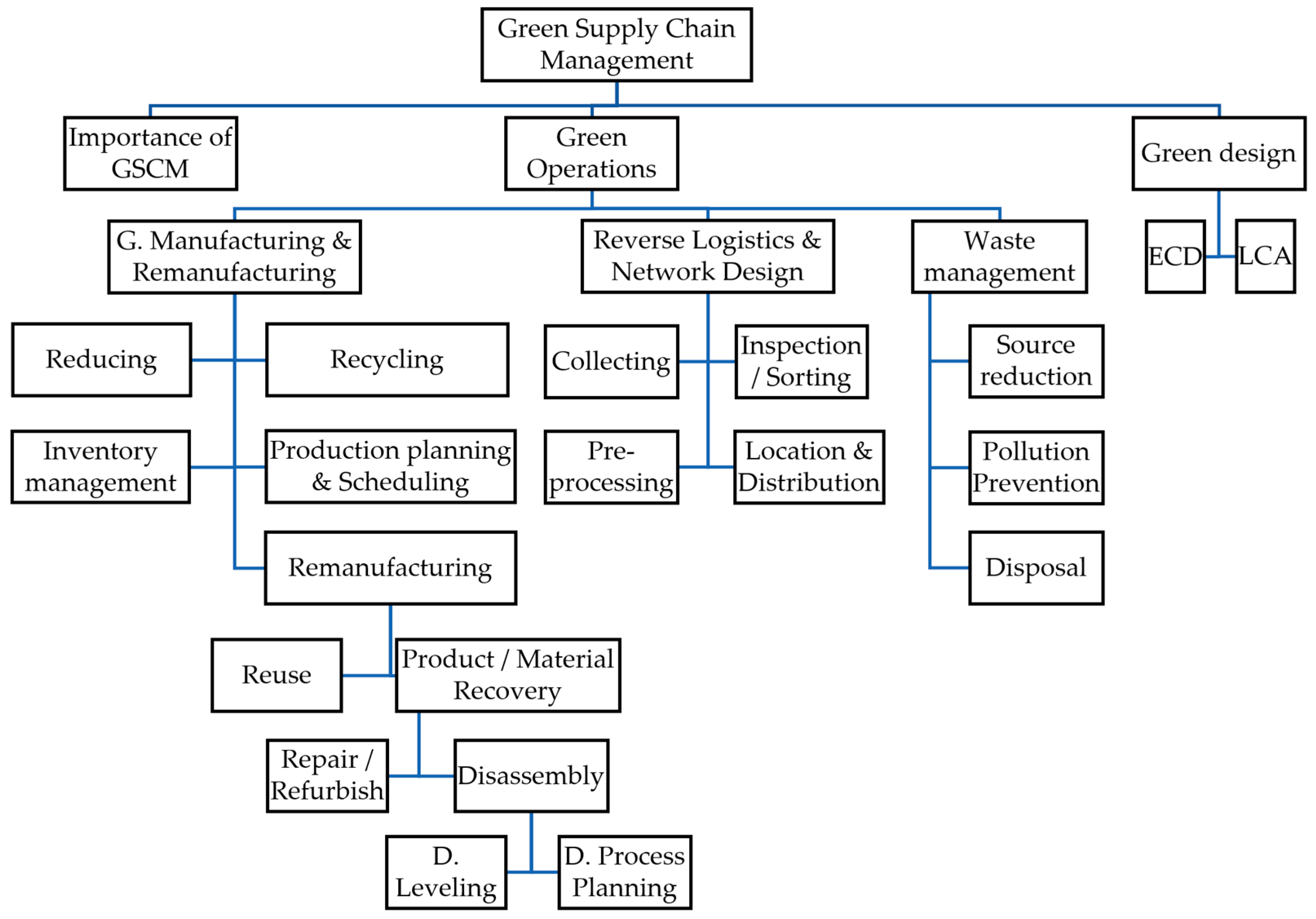
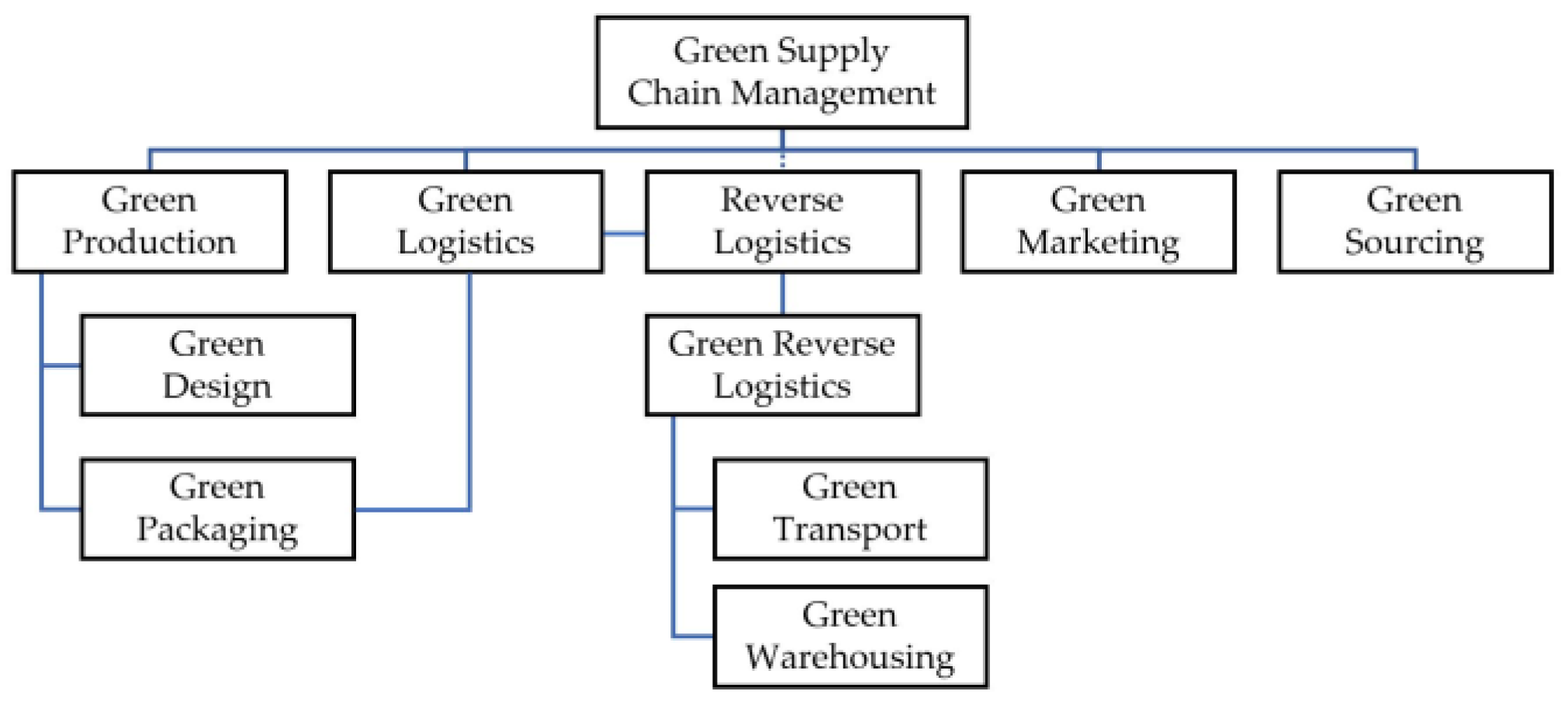
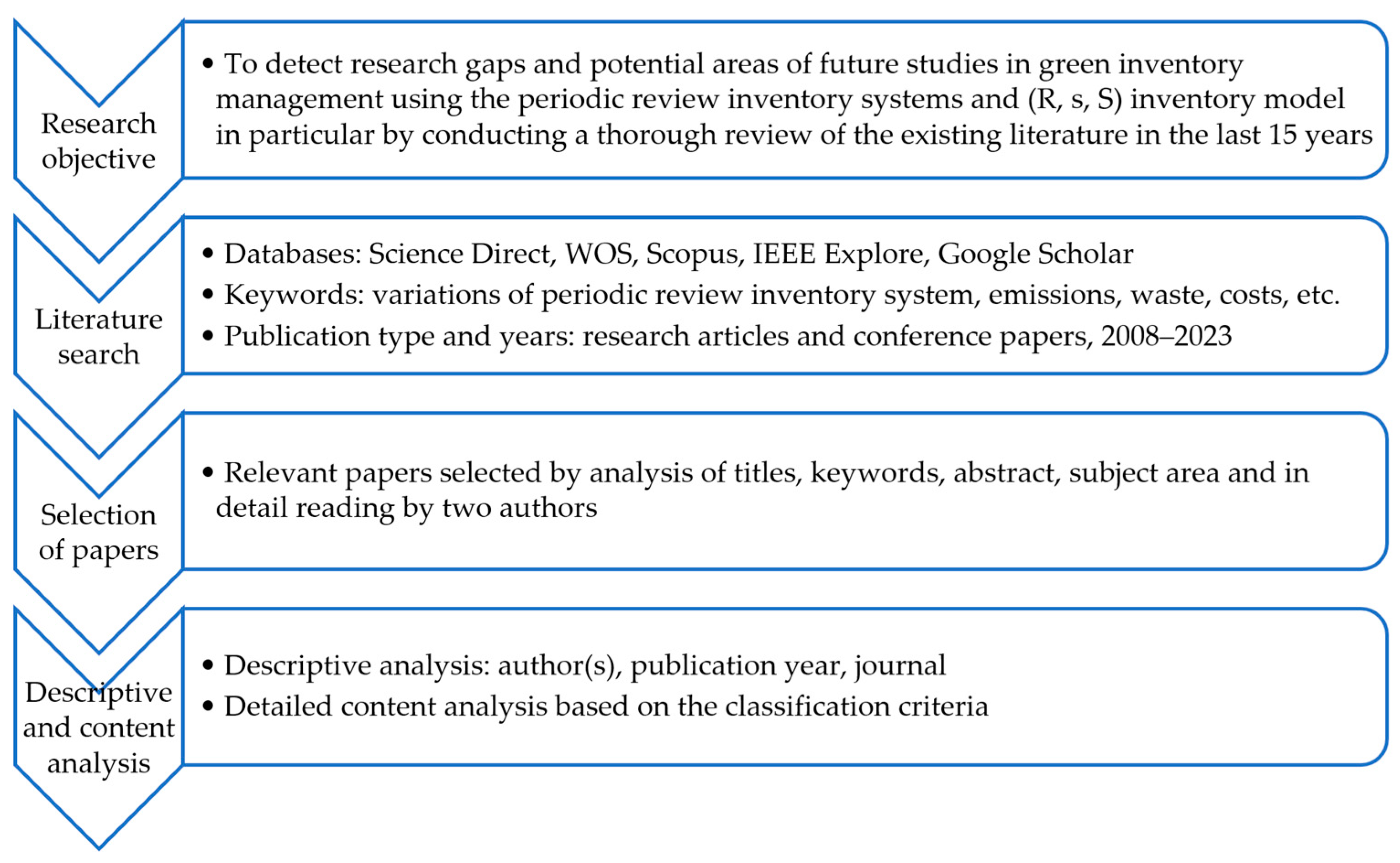

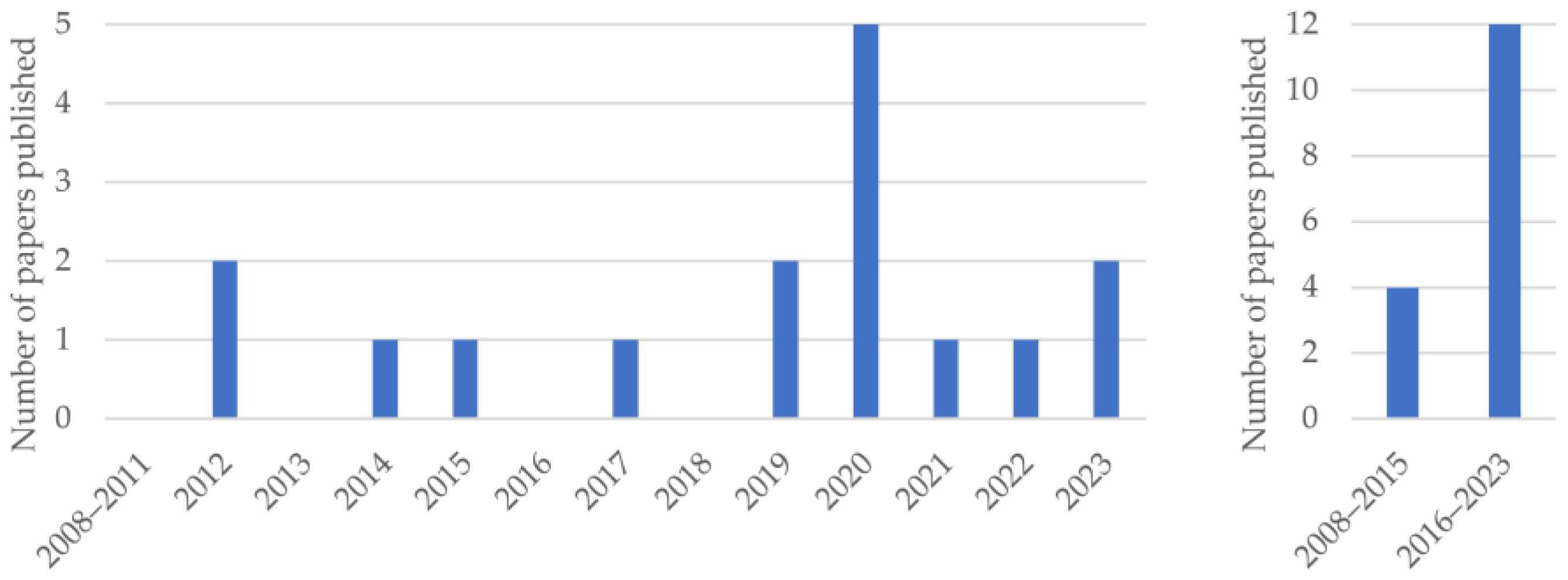
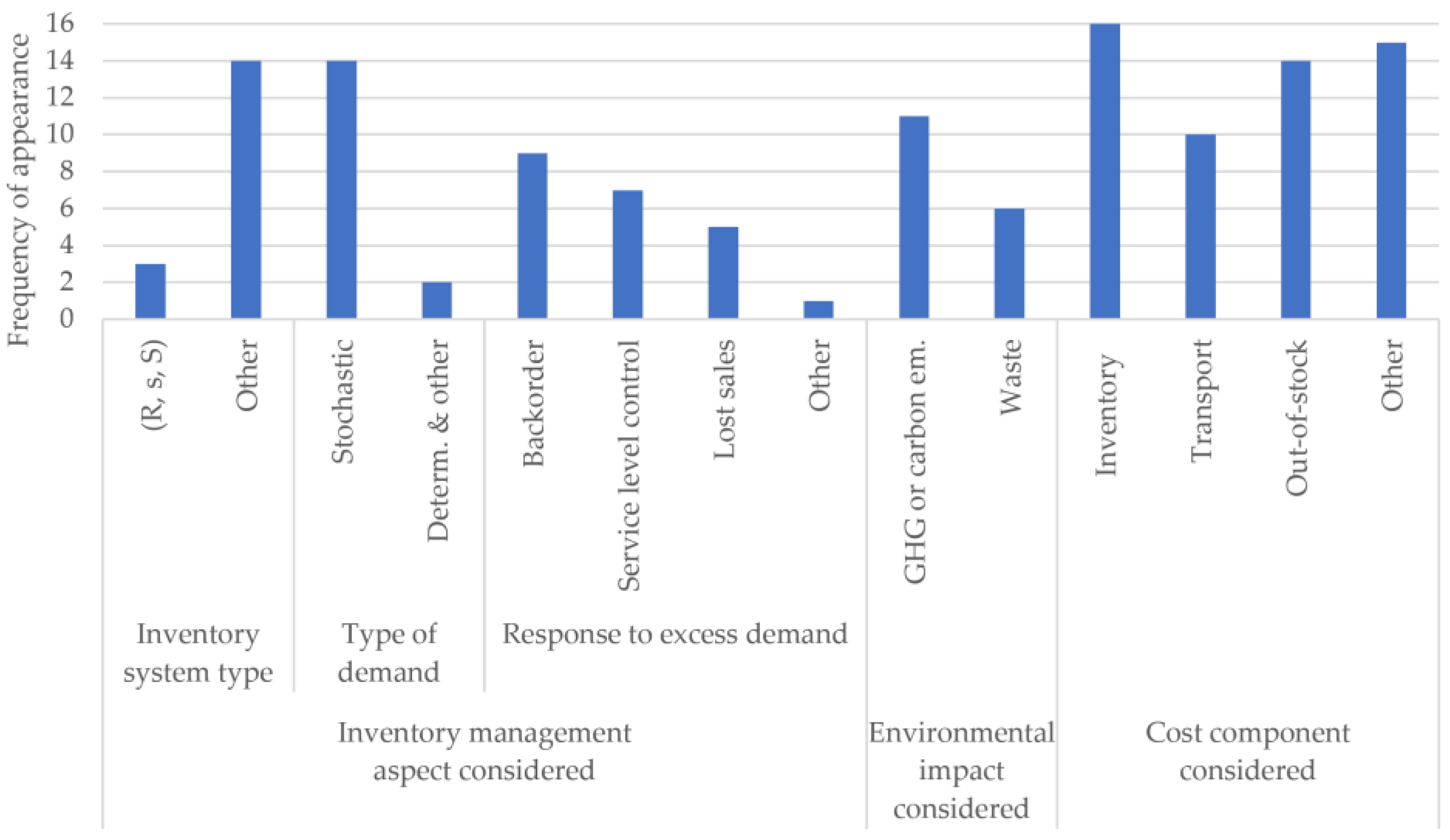

| Authors and Publication Year | Journal | Inventory Management Aspect Considered | Environmental Impact Considered | Cost Component Considered | Model Approach | Optimization Criteria | |||||||
|---|---|---|---|---|---|---|---|---|---|---|---|---|---|
| PRIS Type | Type of Demand | Response to Excess Demand | Source of GHG or Carbon Emissions | Waste | I Cost | T Cost | OS Cost | Other | |||||
| Type | Method of Waste Control or Reduction | ||||||||||||
| Nativi and Lee, 2012 [54] | Int. J. of Production Economics | (R, s, S) | stochastic, Poisson D | backorder | N/A | material from the end-user market | reverse logistics, recycling, reuse | ✓ | ✓ | ✓ | setup, production | MM, S | environmental benefit, costs |
| Ramadhan and Simatupang, 2012 [55] | Procedia—Social and Behavioral Sciences | other | stochastic, normal D | lost sales, SL control | N/A | EP | optimized perishable I management | ✓ | N/A | ✓ | outdating | MM, S | total cost |
| Mallidis et al., 2014 [56] | Transportation Research Part E: Logistics and Transportation Review | other | stochastic, normal D | SL control | T, operation of distribution center | N/A | N/A | ✓ | ✓ | ✓ | operational | analytical, MM | emissions, costs |
| Tang et al., 2015 [41] | Int. J. of Production Economics | other | stochastic, normal D | backorder | T, storage I, backordering | N/A | N/A | ✓ | ✓ | ✓ | N/A | analytical, MM | emissions, costs |
| Rajendran and Ravindran, 2017 [57] | Computers & Industrial Engineering | other | stochastic, normal D | backorder | N/A | EP | optimized perishable I management | ✓ | N/A | ✓ | outdating | empirical, MM, S | total cost |
| Akhtari et al., 2019 [58] | Biosystems Engineering | (R, s, S), other | not defined | lost sales | T, operational processes | N/A | N/A | ✓ | ✓ | N/A | operational | empirical, S | demand fulfillment, emissions, costs |
| Li et al., 2019 [59] | Sustainability | other | stochastic, normal D | backorder | T, I | N/A | N/A | ✓ | N/A | ✓ | carbon | MM, S | I cost, SL, carbon cost |
| Gao et al., 2020 [47] | Computers & Industrial Engineering | other | stochastic, normal D | backorder | T | N/A | N/A | ✓ | ✓ | ✓ | carbon | MM, S | total I cost with carbon emission constraint |
| Liu and Lin, 2020 [60] | Mathematics | other | stochastic, normal, general D | SL control | T | EP | reverse logistics | ✓ | ✓ | ✓ | GHG emission, returning | MM, S | delivery route, order quantities, reordering point, SL, review interval, max I level |
| Noh et al., 2020 [61] | Sustainability | other | deterministic or fuzzy | backorder | ordering, holding I | N/A | N/A | ✓ | N/A | ✓ | carbon tax | MM, S | total cost |
| Ramandi and Bafruei, 2020 [62] | Computers & Industrial Engineering | other | stochastic, normal D | backorder, SL control | T | N/A | N/A | ✓ | ✓ | ✓ | penalty/subsidy related to the emissions level | MM, S | profit, emissions |
| Žic and Žic, 2020 [28] | Advances in Production Engineering & Management | (R, s, S) | stochastic, normal D | lost sales, SL control | T | N/A | N/A | ✓ | ✓ | ✓ | N/A | MM, S | I levels, costs, emissions |
| Kwak, 2021 [24] | Sustainability | other | stochastic, normal D | backorder | T, holding I | N/A | N/A | ✓ | ✓ | ✓ | indirect (sustainability-related) | S | total cost |
| Momeni et al., 2022 [63] | J. of Cleaner Production | other | stochastic, normal D | lost sales, SL control | N/A | EP | reverse logistics, regeneration of EP | ✓ | N/A | ✓ | disposal, production | MM, S | profit, SL |
| Buisman and Rohmer, 2023 [43] | Sustainability Analytics and Modeling | other | stochastic, negative binomial D | lost sales, substitution, SL control | N/A | EP, packaging materials | sales management, recycling, incineration, landfill of packaging materials | ✓ | N/A | N/A | N/A | S | profit, environmental impact |
| Drent et al., 2023 [64] | European J. of Operational Research | other | stochastic, random | backorder | T | N/A | N/A | ✓ | ✓ | ✓ | N/A | MM, S | total I cost with carbon emission constraint |
| Journal | No. of Papers |
|---|---|
| Computers & Industrial Engineering | 3 |
| Sustainability | 3 |
| International Journal of Production Economics | 2 |
| Advances in Production Engineering & Management | 1 |
| Biosystems Engineering | 1 |
| European Journal of Operational Research | 1 |
| Journal of Cleaner Production | 1 |
| Mathematics | 1 |
| Procedia—Social and Behavioral Sciences | 1 |
| Sustainability Analytics and Modeling | 1 |
| Transportation R. Part E: Logistics and Transportation Review | 1 |
Disclaimer/Publisher’s Note: The statements, opinions and data contained in all publications are solely those of the individual author(s) and contributor(s) and not of MDPI and/or the editor(s). MDPI and/or the editor(s) disclaim responsibility for any injury to people or property resulting from any ideas, methods, instructions or products referred to in the content. |
© 2024 by the authors. Licensee MDPI, Basel, Switzerland. This article is an open access article distributed under the terms and conditions of the Creative Commons Attribution (CC BY) license (https://creativecommons.org/licenses/by/4.0/).
Share and Cite
Žic, J.; Žic, S.; Đukić, G.; Dabić-Miletić, S. Exploring Green Inventory Management through Periodic Review Inventory Systems—A Comprehensive Literature Review and Directions for Future Research. Sustainability 2024, 16, 5544. https://doi.org/10.3390/su16135544
Žic J, Žic S, Đukić G, Dabić-Miletić S. Exploring Green Inventory Management through Periodic Review Inventory Systems—A Comprehensive Literature Review and Directions for Future Research. Sustainability. 2024; 16(13):5544. https://doi.org/10.3390/su16135544
Chicago/Turabian StyleŽic, Jasmina, Samir Žic, Goran Đukić, and Svetlana Dabić-Miletić. 2024. "Exploring Green Inventory Management through Periodic Review Inventory Systems—A Comprehensive Literature Review and Directions for Future Research" Sustainability 16, no. 13: 5544. https://doi.org/10.3390/su16135544
APA StyleŽic, J., Žic, S., Đukić, G., & Dabić-Miletić, S. (2024). Exploring Green Inventory Management through Periodic Review Inventory Systems—A Comprehensive Literature Review and Directions for Future Research. Sustainability, 16(13), 5544. https://doi.org/10.3390/su16135544








